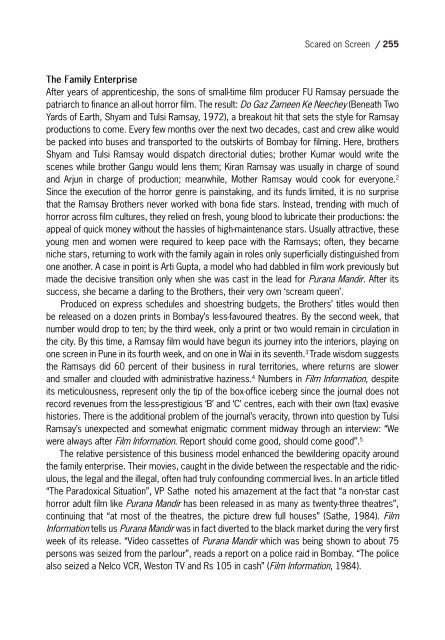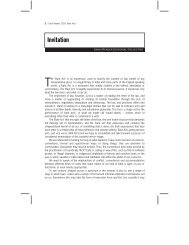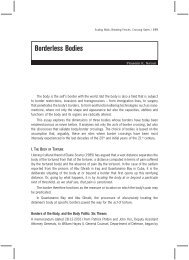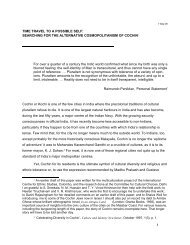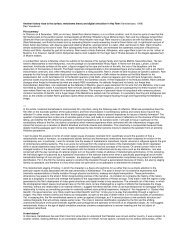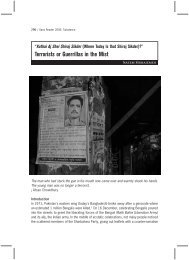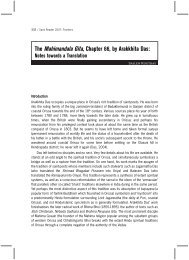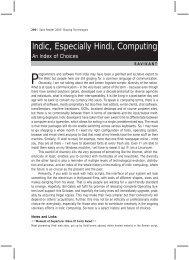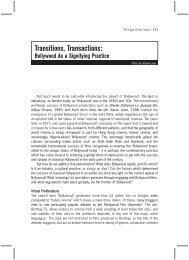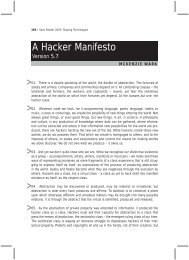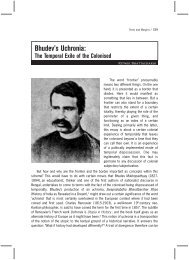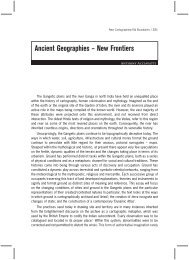Create successful ePaper yourself
Turn your PDF publications into a flip-book with our unique Google optimized e-Paper software.
Scared <strong>on</strong> Screen / 255<br />
The Family Enterprise<br />
After years of apprenticeship, the s<strong>on</strong>s of small-time film producer FU Ramsay persuade the<br />
patriarch to finance an all-out horror film. The result: Do Gaz Zameen Ke Neechey (Beneath Two<br />
Yards of Earth, Shyam and Tulsi Ramsay, 1972), a breakout hit that sets the style for Ramsay<br />
producti<strong>on</strong>s to come. Every few m<strong>on</strong>ths over the next two decades, cast and crew alike would<br />
be packed into buses and transported to the outskirts of Bombay for filming. Here, brothers<br />
Shyam and Tulsi Ramsay would dispatch directorial duties; brother Kumar would write the<br />
scenes while brother Gangu would lens them; Kiran Ramsay was usually in charge of sound<br />
and Arjun in charge of producti<strong>on</strong>; meanwhile, Mother Ramsay would cook for every<strong>on</strong>e. 2<br />
Since the executi<strong>on</strong> of the horror genre is painstaking, and its funds limited, it is no surprise<br />
that the Ramsay Brothers never worked with b<strong>on</strong>a fide stars. Instead, trending with much of<br />
horror across film cultures, they relied <strong>on</strong> fresh, young blood to lubricate their producti<strong>on</strong>s: the<br />
appeal of quick m<strong>on</strong>ey without the hassles of high-maintenance stars. Usually attractive, these<br />
young men and women were required to keep pace with the Ramsays; often, they became<br />
niche stars, returning to work with the family again in roles <strong>on</strong>ly superficially distinguished from<br />
<strong>on</strong>e another. A case in point is Arti Gupta, a model who had dabbled in film work previously but<br />
made the decisive transiti<strong>on</strong> <strong>on</strong>ly when she was cast in the lead for Purana Mandir. After its<br />
success, she became a darling to the Brothers, their very own ‘scream queen’.<br />
Produced <strong>on</strong> express schedules and shoestring budgets, the Brothers’ titles would then<br />
be released <strong>on</strong> a dozen prints in Bombay’s less-favoured theatres. By the sec<strong>on</strong>d week, that<br />
number would drop to ten; by the third week, <strong>on</strong>ly a print or two would remain in circulati<strong>on</strong> in<br />
the city. By this time, a Ramsay film would have begun its journey into the interiors, playing <strong>on</strong><br />
<strong>on</strong>e screen in Pune in its fourth week, and <strong>on</strong> <strong>on</strong>e in Wai in its seventh. 3 Trade wisdom suggests<br />
the Ramsays did 60 percent of their business in rural territories, where returns are slower<br />
and smaller and clouded with administrative haziness. 4 Numbers in <strong>Film</strong> Informati<strong>on</strong>, despite<br />
its meticulousness, represent <strong>on</strong>ly the tip of the box-office iceberg since the journal does not<br />
record revenues from the less-prestigious ‘B’ and ‘C’ centres, each with their own (tax) evasive<br />
histories. There is the additi<strong>on</strong>al problem of the journal’s veracity, thrown into questi<strong>on</strong> by Tulsi<br />
Ramsay’s unexpected and somewhat enigmatic comment midway through an interview: “We<br />
were always after <strong>Film</strong> Informati<strong>on</strong>. Report should come good, should come good”. 5<br />
The relative persistence of this business model enhanced the bewildering opacity around<br />
the family enterprise. Their movies, caught in the divide between the respectable and the ridiculous,<br />
the legal and the illegal, often had truly c<strong>on</strong>founding commercial lives. In an article titled<br />
“The Paradoxical Situati<strong>on</strong>”, VP Sathe noted his amazement at the fact that “a n<strong>on</strong>-star cast<br />
horror adult film like Purana Mandir has been released in as many as twenty-three theatres”,<br />
c<strong>on</strong>tinuing that “at most of the theatres, the picture drew full houses” (Sathe, 1984). <strong>Film</strong><br />
Informati<strong>on</strong> tells us Purana Mandir was in fact diverted to the black market during the very first<br />
week of its release. “Video cassettes of Purana Mandir which was being shown to about 75<br />
pers<strong>on</strong>s was seized from the parlour”, reads a report <strong>on</strong> a police raid in Bombay. “The police<br />
also seized a Nelco VCR, West<strong>on</strong> TV and Rs 105 in cash” (<strong>Film</strong> Informati<strong>on</strong>, 1984).


